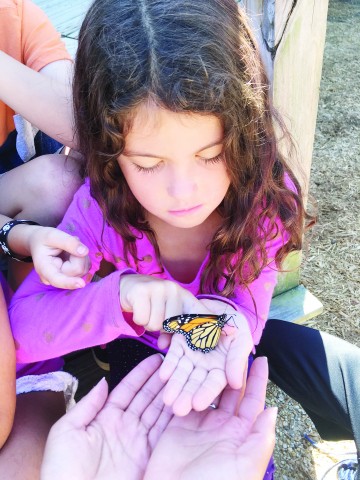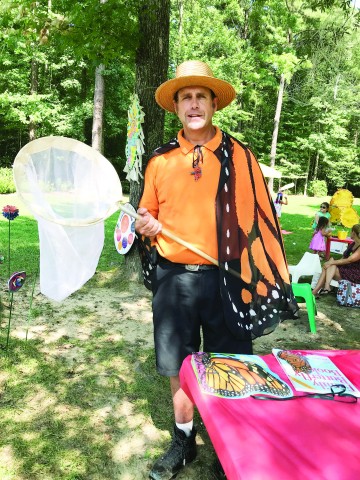It’s Our Turn
By the time fall arrives this month, thousands of Anne Arundel County school students will be studying and rearing monarch butterflies, Danaus plexippus, in their classrooms. Over the next few weeks, regional parks and nature centers have planned monarch events for young and old. All this monarch hoopla coincides with one of nature’s wonders: the eastern monarch population’s migration to Mexico.
Gardeners also are part of the celebrations. This time of year, egg-laying monarch females and resulting caterpillars need welcome mats of native milkweed. Migratory adult butterflies rely on fuel from nectar plants to build up fat reserves. Earlier season monarchs completed their brief life cycles in about a month, but this fourth and last super generation’s reproduction is on hold until next spring. Instead, they’ll spend huge amounts of energy flying 3,000-plus miles to overwintering sites — oyamel fir-forested mountaintops in central Mexico. There, Chesapeake Bay-area monarchs join hundreds of millions of others. They live in dense butterfly colonies for five months, then head north in spring so the cycle begins anew.
This year’s southern flights have already begun. Monarch monitoring groups like Journey North (https://journeynorth.org/monarchs), Monarch Watch (www.monarchwatch.org) and the Monarch Joint Venture (https://monarchjointventure.org) report people seeing an “abundance of monarchs” in trees at overnight roosting sites along the migration path from southern Canada into states north of us. That’s good news for a species that has suffered about an 80 percent decline in just a couple of decades, much of it attributed to habitat loss.
Back to School, for Kids and Monarchs

The timing for this week’s delivery of more than 1,200 monarch caterpillars to 300 or so Anne Arundel County Public School first-grade classrooms couldn’t be better.
Nearly 6,500 first-graders will study and care for their very hungry white, black and yellow-banded classroom guests over the next four to six weeks, hoping to release them as adult butterflies to join the big migration wave south in mid- to late-October. Begun in 2011, the monarch education program was developed by staff at the county school system’s Environmental and Outdoor Education Center, Arlington Echo. At a workshop there last week, new monarch teachers learned how things work.
Students feed caterpillars — or “cats” — precious host milkweed leaves and watch them transform into butterflies, a process called metamorphosis, a big word that all county first-graders learn to use and pronounce. Arlington Echo educator Sean McGuinn who coordinates the program, says students watch their cats, predict how they might grow and record observations in special monarch journals.
Meanwhile, inside mesh cages nicknamed castles, cats go from chunky larvae to jade-and-gold-flecked chrysalises to bright orange-and-black winged members of the insect order, Lepidoptera. After new wings have plumped up and dried, adult monarchs reared in the program get tagged for science with Monarch Watch decals. Young students gain scientific experience, and the data help scientists answer questions about monarch migration. Last year Anne Arundel school kids released about 900 new butterflies, 446 of them tagged. Since the county monarch program began, four monarch tags have been recorded on Mexican butterfly reserves.
Shady Side Elementary School first grade teacher Jennifer Sturgell says she loves the monarch program. “Students can’t wait to learn about monarchs. It’s fun for them to watch the butterfly life cycle up close. And then they want to learn more.” She says students from years ago come back to share monarch stories.
Young students at Magothy Cooperative Pre-School watch caterpillars over time on outdoor milkweed plants, many taller than they are. At Annapolis’ Chesapeake Montessori School, students make connections to classroom subjects like science and geography by studying monarchs and other pollinators in school gardens.
Key School first grade teacher Jeanette Beigel says her students relate to their classroom monarchs. “For about a month, caterpillars live close to us in their little house. Students figure out the insects need the same things we do: food, water, shelter, air and space.” She says they start noticing things people rarely see, like caterpillars pupating or butterflies emerging from chrysalises.
Monarchs Help at Home
To help protect monarchs and aid their recovery, Monarch Watch encourages the creation of monarch way stations, sites including home gardens and schools that offer the habitat and plants monarchs need, especially milkweed. Monarch aficionado and retired USDA scientist Elmer Dengler of Bowie says one of his favorite monarch nectar plants is cut-leaf coneflower: Autumn Sun (Rudbeckia laciniata). “It grows tall, and monarchs and other pollinators love it,” he says.

Maryland’s state flower, black-eyed Susan (Rudbeckia hirta), and Joe Pye weed (Eutrochium purpureum) are other welcoming Mid-Atlantic natives. Mike Callahan says for low-lying saltmarsh areas, like Cobb Island in Charles County, high-tide bush or marsh elder (Iva frutescens) are hits. Always popular with monarchs and other butterflies are garden favorites like zinnias and lantana.
Next year the U.S. Fish and Wildlife Service is set to rule on whether to give monarch butterflies protection under the Endangered Species Act. Already plenty of local children and adults are helping them rebound so their wondrous migrations continue.
Arlington Echo’s Sean McGuinn will share monarch classroom stories and more at this year’s Monarch Fiesta at Jug Bay Wetlands Sanctuary, September 22. The five-county monarch celebration (Anne Arundel, Calvert, Charles, Prince George and St. Mary’s counties) is hosted by the Federated Garden Clubs of Maryland: District 2 and Jug Bay staff.
Organizer Mike Callahan of Nanjemoy Creek Environmental Education Center in Charles County plans to show up in his signature orange-and-black monarch cape, and if the weather cooperates, tag and release ready-to-fly monarchs.
“Celebrating monarchs helps send the message that they are well worth protecting,” he says.
